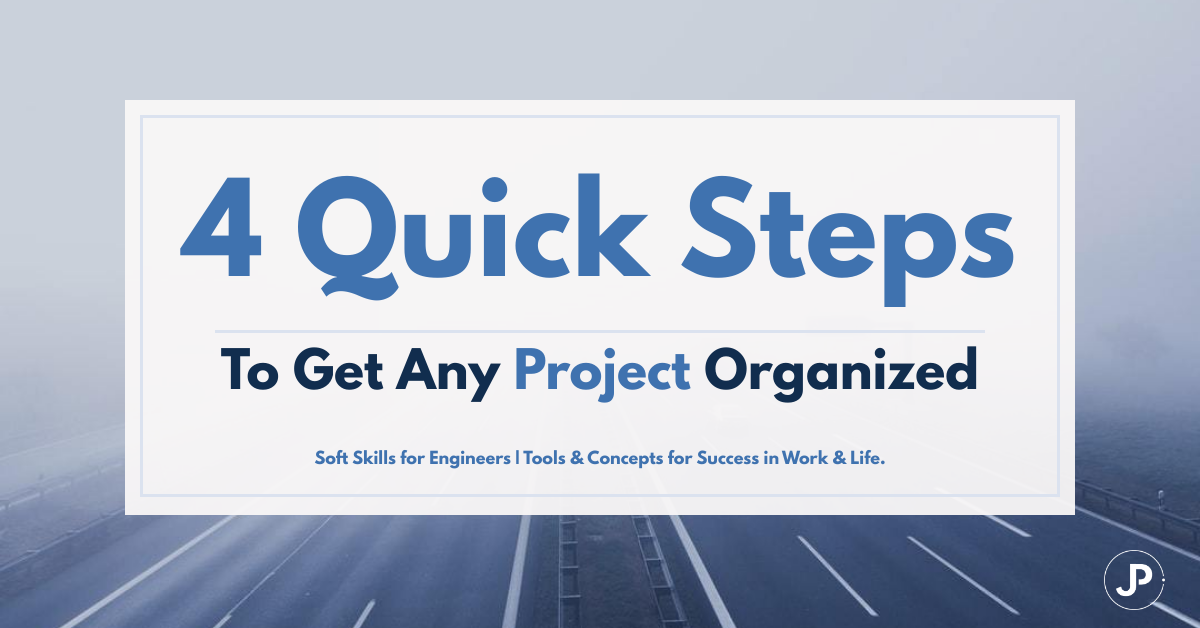How to get any project organized in 4 steps
When you're starting on a new project or trying to get you project back on track, here are some quick steps to get you going.

Getting things done isn’t natural for everyone. But most people make the mistake of thinking it is. They set out to do something they have not done before and expected that they’re going to decide, do, and succeed.
The problem is that it doesn’t work that way.
Established organizations have known this for a long time. And as a result, they have mastered the way to put projects together.
I used to have a big issue with this myself and this lead to a few problems for me like:
- Finishing projects only to find out that it wasn’t what my client had asked for
- Starting a project only to realize that nobody ever agreed on a definition for done
- Finding out at the tail end of the project that I didn’t know what it is that I was working on
- Finding the scope and the requirements of the projects was always shifting
- Finding that the goal of the project was not well defined
I got fed up and decided to make a study of how to get organized.
And I want to share this with you.
The four steps to getting any project organized
1. Clarify your purpose and your goal
The biggest problem with projects is that people don’t decide the ONE THING up front. They don’t say what result you will get after the work is done.
Projects should have one aim which should be a single change that it is seeking to make.
So whenever you need clarity, you need to realign yourself and your team with the goal of the project.
Remember that if you have more than one outcome for a project, then you have more than one destination. Nothing wrong with having many projects at the same time, as long as you know that’s what you’re doing.
2. Come up with a clear picture of done
Knowing what done looks like matters more to project success than anything else.
It gives you a picture of what you’re working to get. If you can communicate that picture to others, then you can get help in moving towards the right target.
An excellent way to think about this is to ask yourself - How would someone else know when you’ve done it right? What physical concrete things would I show to prove that I finished the work?
Then work towards making sure that those items are present by the completion of your project.
3. Brainstorm ways to bring the project about
There are no bad ideas; there are only ideas that don’t meet your current criteria and constraints.
In the beginning of your project or when you’re stuck, corral your ideas and think through what can get you to a done. Leave nothing off the table. Let your brain go.
When all your ideas are out, then you can filter which ones apply based on the constraints that you decided on.
4. Organize your ideas into actions steps and get back to work
Making sure that your action items are concrete and have output will prevent wasted time. So, once you’ve come up with all your ideas, you need to turn them into steps that you can take in the physical world.
Thinking is not a physical action. In truth, I don’t count reading as a physical action either.
You need outputs and artifacts.
- make a phone call about something
- send an email to a person on a topic
- create an outline for something you’re going to write
- create a rough draft or a mind map
- write a summary of an article
- answer specific questions on paper about a problem you’re having
Those are some examples of physical actions. When you’re organizing your ideas, you need to turn things into tangible action steps so that you can keep moving. It reduces the chance of your getting stuck when it’s time to work, and you’re trying to figure out what to do next. Instead, you do it, and you know that it’s moving you towards your destination.
Conclusion
When you’re working on a project, and you need to get it back on track, go back to the basics.
- Figure out what changes the project is trying to make and what you will get when that change happens.
- Get a clear picture that you can communicate of the changes you will make.
- Come up with ways that you can solve that problem
- Finally, organize those things into concrete steps that you can take so that you’re able to get back to work.
It’s somewhat of a mechanical process to go from step to step, but there’s a lot of creativity within those steps.
So go forth and get your projects back on track.
A bit more action...
If you're looking to Push your Productivity to the next level,
I can help. To get notes on what works on productivity and project execution.
Enter your first name and email below to join the Productivity Push:
